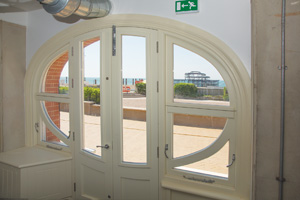Robert Nemeth on West Pier arches

The renovation of the historic seafront to the west of the Palace Pier, encapsulated by the opening of the Brighton Fishing Museum in 1992, is one of the tourism success stories of modern Brighton. But the area around the West Pier has languished ever since its decaying arches were boarded up in 1993.
Encouragingly, a complete rebuild of the 26 leaking 1880s arches to the west of the West Pier has just been completed after a year of careful thought and hard graft. They are intended for artists and other creative-types, and will no doubt assist the forthcoming i360 in totally transforming this part of the beach and Preston Street above.
“Brighton’s heraldic dolphins stand proud and obvious”
It is easy to forget that the seafront arches were principally built to hold up a new road/pavement when the coast road was extended over the low chalk cliffs. Leon Bellis, Senior Engineer at Brighton & Hove City Council, along with C. J. Thorne as principal contractors, Amey as engineers and Solar as architects, have completely rebuilt the arches (which Leon treats as ‘a bridge’) in an updated version of their original form.

A whole set of new bricks from Ibstock has been made and carefully pieced together to create a gleaming new façade. Above, new railings, slightly taller than the originals, have been cast. Brighton’s heraldic dolphins, which are obscured by paint along the rest of the seafront, stand proud and obvious. Brand new doors and windows in iroko, a hardwood from tropical Africa, have been painstakingly designed (without originals to go by) and made by Seth Evans Joinery – whose work with photographer Paul Fletcher drew my attention to the project generally.
The new arches should be waterproof for 50+ years and have a design life of 120+ years. They can take loads of 40 tonnes (more than a dust cart or fire engine). Blast furnace slag has been used within the arches’ high-strength concrete to increase resistance to sulphates and chlorides (which, perhaps unintentionally, is also an eco feature).
The new units consist of two arches apiece and have an industrial feel inside. I particularly like it that the 1880s brick wall behind has been left exposed and that the concrete shuttering lines on the ceilings are a deliberate feature.
I’m looking forward to the units being filled quickly – and the units to the east of the West Pier being completed so that I can get exploring.
www.buildingopinions.com
robert@buildingopinions.com
Follow me: @robert_nemeth




















